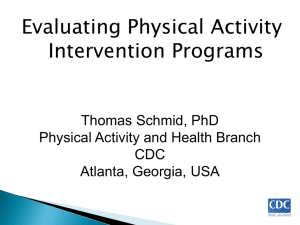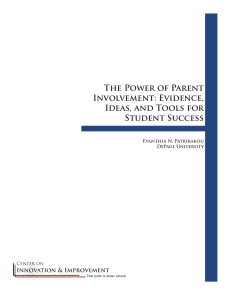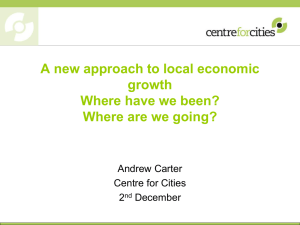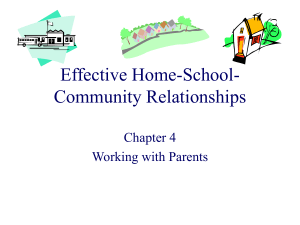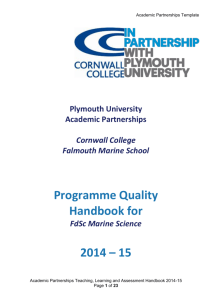Family and Community Engagement
advertisement
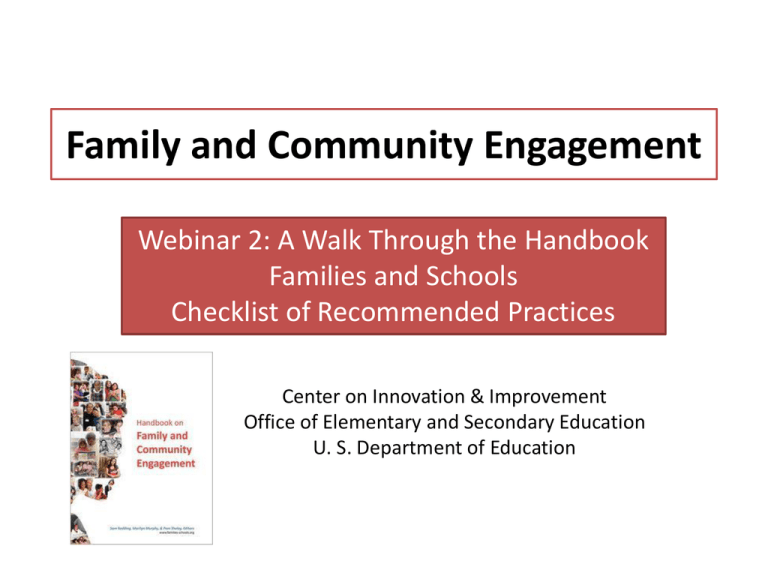
Family and Community Engagement Webinar 2: A Walk Through the Handbook Families and Schools Checklist of Recommended Practices Center on Innovation & Improvement Office of Elementary and Secondary Education U. S. Department of Education Welcome! Download the Handbook free from: www.families-schools.org Or purchase the published version from: Information Age Publishing www.infoagepub.com How the Handbook is Organized? • • • • Part I: Framing the Discussion Part II: Families and Learning Part III: Families and Schools Part IV: Checklist of Suggested Practices Why the Handbook? • • • • • • Bring best research together in one place Add the wisdom of many voices Present in a straight-forward manner Provide practical application Include ample references and resources Leaven with a dash of reality with vignettes Part III: Families and Schools • A Framework for Partnerships • Parent Leadership • Maximum Homework Impact: Optimizing Time, Purpose, Communication, and Collaboration • Differentiating Family Supports • Bridging Language and Culture • Minority Families and Schooling • Association of Poverty with Family Relations and Children’s and Adolescents’ Socio-emotional Adjustment Part III: Families and Schools • Families of Children with Disabilities: Building School-Family Partnerships • Linking Schools to Early Childhood • Family Engagement in High Schools • Family and Community Engagement in Charter Schools • Family Engagement in Rural Schools • Bridging Two Worlds for Native American Families A Framework for Partnerships Steven B. Sheldon “The four organizational principles for a strong partnership program are: (1) employing teamwork; (2) writing annual, goal-oriented action plans; (3) using a multidimensional definition of involvement or engagement; and (4) evaluating partnership practices.” Parent Leadership Anne T. Henderson & Sam Redding “Where leadership is shared with parents, research demonstrates its power in boosting school improvement. It also accesses an untapped resource and lifts the life prospects of the parent leaders themselves.” Maximum Homework Impact: Optimizing Time, Purpose, Communication, and Collaboration— Frances Van Voorhis “Teachers play critical roles in homework design, student perception, and encouraging appropriate levels of family involvement.” Differentiating Family Supports Patricia Edwards “The rationale for differentiating family supports comes from theory, research, and educational common sense. Educators must understand that parents are not all the same. They have their own strengths and weaknesses, complexities, problems, and questions, and we must work with them and see them as more than ‘just parents.’” Bridging Language and Culture Patricia Gándara “Our greatest concern must be with those parents and children who do not have the social capital or the English skills to be able to navigate the education system.” Minority Families and Schooling Susan Paik “Many minority families tend to reside in poor neighborhoods. Facing cultural, language, and economic barriers, their children’s achievement gap widens throughout the school years.” Pause to Reflect What struck a chord with you in these Part III chapters? – Jot a couple notes for the discussion later. Association of Poverty with Family Relations and Children’s and Adolescents’ Socio-emotional Adjustment Ronald Taylor “The effects of poverty and economic problems on children are indirect and operate through their impact on parents’ adjustment, interpersonal relations, and parenting practices.” Families of Children with Disabilities: Building School-Family Partnerships Eva Patrikakou “A key factor in establishing and maintaining home–school partnerships is ongoing and productive communication. The need for communication between educators and families becomes even greater for students with disabilities.” Linking Schools to Early Childhood Kate McGilly “A child who is ready for school is socially, emotionally, and cognitively ready. The contexts in which children develop from birth—the relationships they form, the environments in which they are placed, the responsiveness of those environments—are predictive of readiness for and later success in school.” Family Engagement in High Schools Mavis Sanders “Adolescents’ success in high school is enhanced by home-based family engagement and communication practices. Further, communications about school and postsecondary plans between parents and adolescents and among parents, adolescents, and school teachers are positively associated with students’ school success.” Family and Community Engagement in Charter Schools Brian R. Beabout & Lindsey B. Jakiel “Increasing the levels of family and community engagement in schools has been an important rationale for the creation of charter schools from the beginnings of the movement in the early 1990s.” Family Engagement in Rural Schools Amanda Witte and Susan Sheridan “Rural schools are uniquely positioned to foster and benefit from family–school partnerships. Because of their centrality within the community, rural schools routinely connect with families in multiple capacities as part of typical daily routines.” Bridging Two Worlds for Native American Families Pamela Sheley • Persistence matters. Enlist the willing parents who attend school functions to to help communicate with other families. Talk to the tribal council and involve them in the school. Speak to the elders and include them when teaching the students of their heritage and culture. Invite parents in to share special skills related to supporting at home their children’s success at school.” Pause to Reflect What struck a chord with you in these Part III chapters? – Jot a couple notes for the discussion later. Part IV: Checklist of Suggested Practices Sam Redding “Each contributor brought to the Handbook his or her own passions, special interests, personal background, and experience. The contributors synthesized the research and offered practical action principles for State Education Agencies, Local Education Agencies, and schools. This chapter provides a checklist of suggested practices derived from the action principles in the preceding chapters.” The Vignettes • • • • Angela, by Patricia Edwards Billy, by Sam Redding Tony, by Lori Thomas Marie, by Pamela Sheley Discussion 1. What struck a chord with you in Parts III and IV, and how does it relate to your role? 2. What question do you have that one of the webinar participants or facilitators might be able to answer?


